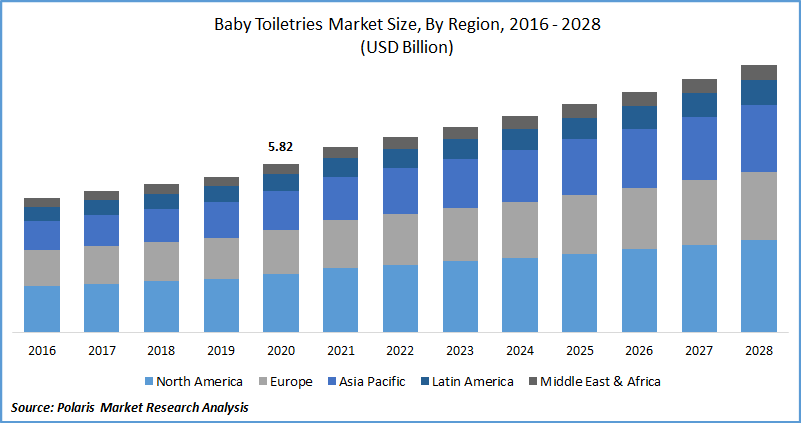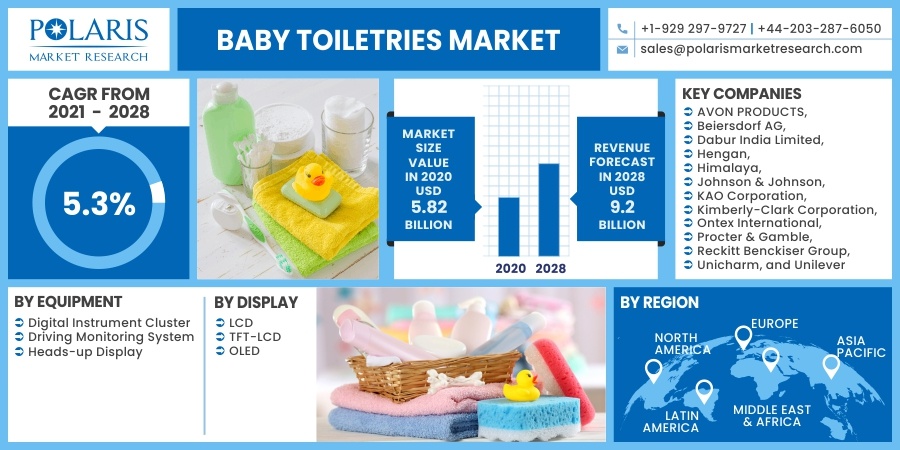
Baby Toiletries Market Share, Size, Trends, Industry Analysis Report, By Product (Skin Care, Diapers, Hair Care, Wipes, Bathing); Distribution Channel (Hypermarkets, Chemist & Pharmacy Stores, E-Commerce, Others); By Region; Segment Forecast, 2021 - 2028
- Published Date:Oct-2021
- Pages: 113
- Format: PDF
- Report ID: PM2076
- Base Year: 2020
- Historical Data: 2016 - 2019
Report Outlook
The global baby toiletries market was valued at USD 5.82 billion in 2020 and is expected to grow at a CAGR of 5.3% during the forecast period. The continual rise in the birth rate worldwide, coupled with the increasing inclination for clinically tested products, are significant factors likely to accelerate the baby toiletries industry growth over the forecast period. Moreover, the robust penetration of natural or herbal care products and escalating initiatives for the healthcare activities by public-private companies is further boosting the adoption of baby toiletries in the global market.
 Know more about this report: request for sample pages
Know more about this report: request for sample pages
Baby toiletries is a term generally used for all essential baby care goods and mainly utilized for nurturing the safety and hygiene of toddlers or babies. These toiletries products such as diapers, wipes, skin care, and many more are simply accessible in the various conventional stores, online stores, or super or hypermarkets. These products are safe for the use of babies because this is specifically produced for the consumption of babies and is manufactured with significantly less or without the usage of any chemical content.
Rising responsiveness regarding the health and benefits of such products is one of the significant factors that accelerates the demand for baby toiletries in the global market. According to macrotrend.net, in 2020, the global infant mortality rate was 27.97 deaths per 1000 live births. The root cause of the deaths is diarrheal diseases and other infectious diseases among children.
Consequently, the leading companies in the baby toiletries market launch numerous health and hygiene campaigns. For instance, several NGOs like National Diaper banks and Kimberly Clarks Huggies step forward to raising awareness among parents or caretakers for the usage of biodegradable diapers and giving comprehensive aid to toddlers’ health. Thus, this factor may drive the baby toiletries industry growth in the overall global market.

Know more about this report: request for sample pages
Industry Dynamics
Growth Drivers
The proliferation of baby toiletries is intensifying at a substantial pace considering the universal situation. With the increasing number of births in countries like China, India, and U.S., the consumption of baby toiletries and products is constantly rising. Baby toiletries consist of toothbrushes, toothpaste, diapers, shampoo, and many others utilized for babies by five. Therefore, the growing number of births directly affects the baby toiletries industry growth across the market.
Furthermore, the public and private companies present in varied nations, mostly in developing countries such as India and China, are targeting to invest in the development of the companies, which may encourage the demand for baby toiletries. Thus, it plays a significant role in shifting the dynamics of the baby toiletries industry shortly worldwide.
Report Segmentation
The market is primarily segmented on the basis of product, distribution channel, and region.
|
By Product |
By Distribution Channel |
By Region |
|
|
|
Know more about this report: request for sample pages
Insight by Product
Diapers segment held the dominating position and anticipated to grow in the forthcoming period. The escalating number of working females all over the world contributes to the growing demand for diapers in the market. They are the primary purchasers of baby toiletries, particularly diapers, providing better care during their hectic schedules. For instance, in 2018, around 75,978,000 females aged 16 and more were part of the U.S. labor force, according to the Bureau of Labor Statistics (BLS). Thus, the rising existence of employed women may fuel market growth.
Skincare product is projected to rise at a higher pace shortly. This is due to the launch of various toiletries products by the existing firms. To maintain proper hygiene, parents are more inclined towards the adoption of skincare products. For instance, to prevent a toddler’s skin from dryness and irritation, baby lotions are mostly preferred for softening and moistening their skin. Similarly, baby shampoos are usually used for gentle washing of their sensitive skin or hair. Therefore, increasing consciousness for a toddler’s gentle care paves the way for market growth.
Insight by Distribution Channel
Hypermarkets are obtaining the largest share in the global baby toiletries industry. The leading participants in the segment include Walmart, SPAR, and Target, which introduces their new store's locations in varied locations comprising China, India, U.S., the U.K., and Germany for budding their consumers base across various regions. By 2020, Target Brands Inc. is inaugurating nearly 25 new stores in the U.S. as per company details. This factor directly acts as a catalyzing factor for fueling market growth.
E-commerce segment is likely to spur at the highest CAGR. The segment is usually selected by population according to its features such as free product delivery, more convenience, after-sale services, hassle-free return, and accessible mode of payment. The online vendors proposed a varied option of baby toiletries with seasonally great discounts and special pricing offers to the users. Also, retailers offer a feature to share the feedback of the products for better finalizing by the customers. All these factors are likely to be attributed to the market growth.
Geographic Overview
Geographically, North America conquered the global baby toiletries industry and accounted for the largest share in terms of revenue, owing to the existence of the major market players such as Johnson & Johnson Limited, Kimberly-Clark Corporation, and Procter & Gamble Company. The organizations are constantly working on innovation, product advancement, and research and development for the fascinating large number of populations in North America.
For instance, Johnson & Johnson declared in May 2018 to re-launch its care product line consisting of powder and shampoos in the market. These toiletries are designed for the millennial mother, who is carefully looking for toddler care and free from artificial cologne, parabens, and phthalates.
Moreover, Asia Pacific is projected to witness the fastest growth rate in the global baby toiletries market. Factors such as increasing awareness for the toddler’s health and hygiene, growing population in this region, rising household income, and developing economies may positively influence the growth of the market. For example, China is likely to be in a middle-class society, by 2030, with 52% of the adults in upper levels of income shadowed by the 33% in the middle-income group.
Competitive Landscape
Some of the Major Players operating the global baby toiletries market include AVON PRODUCTS, Beiersdorf AG, Dabur India Limited, Hengan, Himalaya, Johnson & Johnson, KAO Corporation, Kimberly-Clark Corporation, Ontex International, Procter & Gamble, Reckitt Benckiser Group, Unicharm, and Unilever.
Baby Toiletries Market Report Scope
|
Report Attributes |
Details |
|
Market size value in 2020 |
USD 5.82 billion |
|
Revenue forecast in 2028 |
USD 9.2 billion |
|
CAGR |
5.3% from 2021 - 2028 |
|
Base year |
2020 |
|
Historical data |
2016 - 2019 |
|
Forecast period |
2021 - 2028 |
|
Quantitative units |
Revenue in USD billion and CAGR from 2021 to 2028 |
|
Segments covered |
By Product, By Distribution Channel, By Region |
|
Regional scope |
North America, Europe, Asia Pacific, Latin America, Middle East & Africa |
|
Key Companies |
AVON PRODUCTS, Beiersdorf AG, Dabur India Limited, Hengan, Himalaya, Johnson & Johnson, KAO Corporation, Kimberly-Clark Corporation, Ontex International, Procter & Gamble, Reckitt Benckiser Group, Unicharm, and Unilever |
